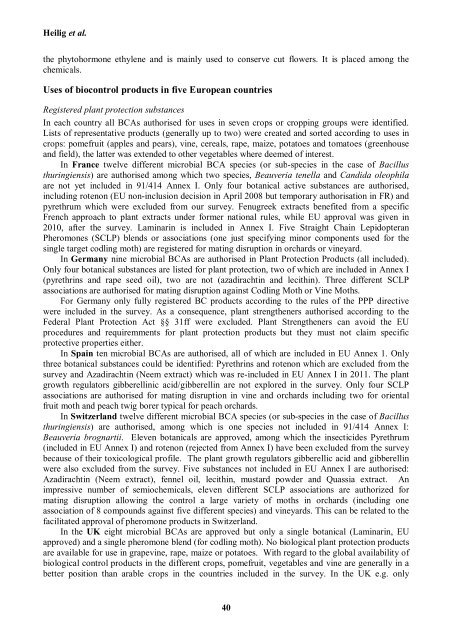Classical and augmentative biological control against ... - IOBC-WPRS
Classical and augmentative biological control against ... - IOBC-WPRS
Classical and augmentative biological control against ... - IOBC-WPRS
You also want an ePaper? Increase the reach of your titles
YUMPU automatically turns print PDFs into web optimized ePapers that Google loves.
Heilig et al.<br />
the phytohormone ethylene <strong>and</strong> is mainly used to conserve cut flowers. It is placed among the<br />
chemicals.<br />
Uses of bio<strong>control</strong> products in five European countries<br />
Registered plant protection substances<br />
In each country all BCAs authorised for uses in seven crops or cropping groups were identified.<br />
Lists of representative products (generally up to two) were created <strong>and</strong> sorted according to uses in<br />
crops: pomefruit (apples <strong>and</strong> pears), vine, cereals, rape, maize, potatoes <strong>and</strong> tomatoes (greenhouse<br />
<strong>and</strong> field), the latter was extended to other vegetables where deemed of interest.<br />
In France twelve different microbial BCA species (or sub-species in the case of Bacillus<br />
thuringiensis) are authorised among which two species, Beauveria tenella <strong>and</strong> C<strong>and</strong>ida oleophila<br />
are not yet included in 91/414 Annex I. Only four botanical active substances are authorised,<br />
including rotenon (EU non-inclusion decision in April 2008 but temporary authorisation in FR) <strong>and</strong><br />
pyrethrum which were excluded from our survey. Fenugreek extracts benefited from a specific<br />
French approach to plant extracts under former national rules, while EU approval was given in<br />
2010, after the survey. Laminarin is included in Annex I. Five Straight Chain Lepidopteran<br />
Pheromones (SCLP) blends or associations (one just specifying minor components used for the<br />
single target codling moth) are registered for mating disruption in orchards or vineyard.<br />
In Germany nine microbial BCAs are authorised in Plant Protection Products (all included).<br />
Only four botanical substances are listed for plant protection, two of which are included in Annex I<br />
(pyrethrins <strong>and</strong> rape seed oil), two are not (azadirachtin <strong>and</strong> lecithin). Three different SCLP<br />
associations are authorised for mating disruption <strong>against</strong> Codling Moth or Vine Moths.<br />
For Germany only fully registered BC products according to the rules of the PPP directive<br />
were included in the survey. As a consequence, plant strengtheners authorised according to the<br />
Federal Plant Protection Act §§ 31ff were excluded. Plant Strengtheners can avoid the EU<br />
procedures <strong>and</strong> requiremments for plant protection products but they must not claim specific<br />
protective properties either.<br />
In Spain ten microbial BCAs are authorised, all of which are included in EU Annex 1. Only<br />
three botanical substances could be identified: Pyrethrins <strong>and</strong> rotenon which are excluded from the<br />
survey <strong>and</strong> Azadirachtin (Neem extract) which was re-included in EU Annex I in 2011. The plant<br />
growth regulators gibberellinic acid/gibberellin are not explored in the survey. Only four SCLP<br />
associations are authorised for mating disruption in vine <strong>and</strong> orchards including two for oriental<br />
fruit moth <strong>and</strong> peach twig borer typical for peach orchards.<br />
In Switzerl<strong>and</strong> twelve different microbial BCA species (or sub-species in the case of Bacillus<br />
thuringiensis) are authorised, among which is one species not included in 91/414 Annex I:<br />
Beauveria brognartii. Eleven botanicals are approved, among which the insecticides Pyrethrum<br />
(included in EU Annex I) <strong>and</strong> rotenon (rejected from Annex I) have been excluded from the survey<br />
because of their toxicological profile. The plant growth regulators gibberellic acid <strong>and</strong> gibberellin<br />
were also excluded from the survey. Five substances not included in EU Annex I are authorised:<br />
Azadirachtin (Neem extract), fennel oil, lecithin, mustard powder <strong>and</strong> Quassia extract. An<br />
impressive number of semiochemicals, eleven different SCLP associations are authorized for<br />
mating disruption allowing the <strong>control</strong> a large variety of moths in orchards (including one<br />
association of 8 compounds <strong>against</strong> five different species) <strong>and</strong> vineyards. This can be related to the<br />
facilitated approval of pheromone products in Switzerl<strong>and</strong>.<br />
In the UK eight microbial BCAs are approved but only a single botanical (Laminarin, EU<br />
approved) <strong>and</strong> a single pheromone blend (for codling moth). No <strong>biological</strong> plant protection products<br />
are available for use in grapevine, rape, maize or potatoes. With regard to the global availability of<br />
<strong>biological</strong> <strong>control</strong> products in the different crops, pomefruit, vegetables <strong>and</strong> vine are generally in a<br />
better position than arable crops in the countries included in the survey. In the UK e.g. only<br />
40

















